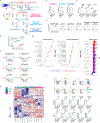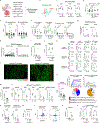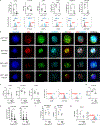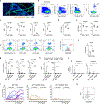Bone marrow niches orchestrate stem-cell hierarchy and immune tolerance
- PMID: 39743593
- PMCID: PMC11956426
- DOI: 10.1038/s41586-024-08352-6
Bone marrow niches orchestrate stem-cell hierarchy and immune tolerance
Abstract
Stem cells reside in specialized microenvironments, termed niches, at several different locations in tissues1-3. The differential functions of heterogeneous stem cells and niches are important given the increasing clinical applications of stem-cell transplantation and immunotherapy. Whether hierarchical structures among stem cells at distinct niches exist and further control aspects of immune tolerance is unknown. Here we describe previously unknown new hierarchical arrangements in haematopoietic stem cells (HSCs) and bone marrow niches that dictate both regenerative potential and immune privilege. High-level nitric oxide-generating (NOhi) HSCs are refractory to immune attack and exhibit delayed albeit robust long-term reconstitution. Such highly immune-privileged, primitive NOhi HSCs co-localize with distinctive capillaries characterized by primary ciliated endothelium and high levels of the immune-checkpoint molecule CD200. These capillaries regulate the regenerative functions of NOhi HSCs through the ciliary protein IFT20 together with CD200, endothelial nitric oxide synthase and autophagy signals, which further mediate immunoprotection. Notably, previously described niche constituents, sinusoidal cells and type-H vessels2-10 co-localize with less immune-privileged and less potent NOlow HSCs. Together, we identify highly immune-privileged, late-rising primitive HSCs and characterize their immunoprotective niches comprising specialized vascular domains. Our results indicate that the niche orchestrates hierarchy in stem cells and immune tolerance, and highlight future immunotherapeutic targets.
© 2025. The Author(s), under exclusive licence to Springer Nature Limited.
Conflict of interest statement
Competing interests: S.C.R. is a scientific founder of Purinomia Biotech and consults for eGenesis; his interests are reviewed and managed by HMFP at the Beth Israel Deaconess Medical Center following their conflict-of-interest policies. All other authors declare no competing interests.
Figures
















References
MeSH terms
Substances
Grants and funding
LinkOut - more resources
Full Text Sources
Medical
Molecular Biology Databases

